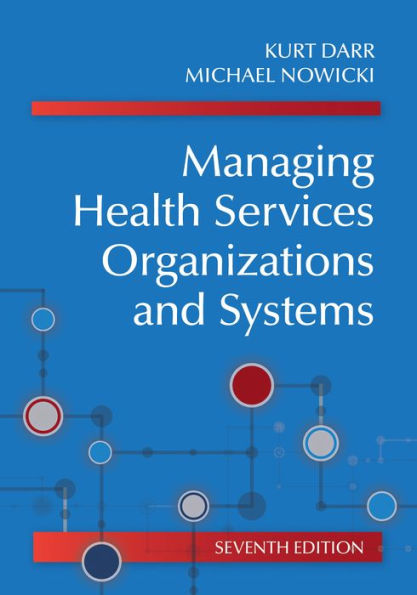Managing Health Services Organizations and Systems has served the educational and professional needs of the healthcare field over four decades. The seventh edition furthers that legacy in a completely revised and reorganized text that presents a comprehensive range of the knowledge and skills needed to effectively lead and manage health services delivery. The first of three parts describes the environment in which health services are delivered. The second details tools and skills needed to manage and lead health services. The final part links the preceding chapters to Fayol’s five management functions—planning, organizing, staffing, directing, and controlling—as they apply in health services. In this edition, the authors return to basics in a concise yet substantive presentation within a context of quality and performance improvement. New to this edition are chapters on healthcare economics, financial management, planning, organizing, staffing, and directing. A new section on compliance is key to meeting regulatory demands. The sections on patient and staff safety, emergency preparedness, and project management are updated and revised. Additional highlights include
• Revised and supplemented end-of-chapter discussion questions
• 52 thought-provoking case studies, at least half of them new to this edition
• Extensive source citations, many with URLs leading to additional sources for reading and research
• List of acronyms
• Detailed index
• Supporting instructor materials, including 58 additional case studies
Managing Health Services Organizations and Systems is a vital resource for developing health service leaders and managers. It is
• A textbook for graduate and undergraduate courses in health services management
• A resource for nonformal education such as seminars, webinars, and self-instruction
• An enduring professional reference with encyclopedic information. Busy practitioners will value the readily available acronym list, detailed index, and regulatory and statutory references.
1138089805
• Revised and supplemented end-of-chapter discussion questions
• 52 thought-provoking case studies, at least half of them new to this edition
• Extensive source citations, many with URLs leading to additional sources for reading and research
• List of acronyms
• Detailed index
• Supporting instructor materials, including 58 additional case studies
Managing Health Services Organizations and Systems is a vital resource for developing health service leaders and managers. It is
• A textbook for graduate and undergraduate courses in health services management
• A resource for nonformal education such as seminars, webinars, and self-instruction
• An enduring professional reference with encyclopedic information. Busy practitioners will value the readily available acronym list, detailed index, and regulatory and statutory references.
Managing Health Services Organizations and Systems, Seventh Edition
Managing Health Services Organizations and Systems has served the educational and professional needs of the healthcare field over four decades. The seventh edition furthers that legacy in a completely revised and reorganized text that presents a comprehensive range of the knowledge and skills needed to effectively lead and manage health services delivery. The first of three parts describes the environment in which health services are delivered. The second details tools and skills needed to manage and lead health services. The final part links the preceding chapters to Fayol’s five management functions—planning, organizing, staffing, directing, and controlling—as they apply in health services. In this edition, the authors return to basics in a concise yet substantive presentation within a context of quality and performance improvement. New to this edition are chapters on healthcare economics, financial management, planning, organizing, staffing, and directing. A new section on compliance is key to meeting regulatory demands. The sections on patient and staff safety, emergency preparedness, and project management are updated and revised. Additional highlights include
• Revised and supplemented end-of-chapter discussion questions
• 52 thought-provoking case studies, at least half of them new to this edition
• Extensive source citations, many with URLs leading to additional sources for reading and research
• List of acronyms
• Detailed index
• Supporting instructor materials, including 58 additional case studies
Managing Health Services Organizations and Systems is a vital resource for developing health service leaders and managers. It is
• A textbook for graduate and undergraduate courses in health services management
• A resource for nonformal education such as seminars, webinars, and self-instruction
• An enduring professional reference with encyclopedic information. Busy practitioners will value the readily available acronym list, detailed index, and regulatory and statutory references.
• Revised and supplemented end-of-chapter discussion questions
• 52 thought-provoking case studies, at least half of them new to this edition
• Extensive source citations, many with URLs leading to additional sources for reading and research
• List of acronyms
• Detailed index
• Supporting instructor materials, including 58 additional case studies
Managing Health Services Organizations and Systems is a vital resource for developing health service leaders and managers. It is
• A textbook for graduate and undergraduate courses in health services management
• A resource for nonformal education such as seminars, webinars, and self-instruction
• An enduring professional reference with encyclopedic information. Busy practitioners will value the readily available acronym list, detailed index, and regulatory and statutory references.
138.99
In Stock
5
1

Managing Health Services Organizations and Systems, Seventh Edition
636
Managing Health Services Organizations and Systems, Seventh Edition
636eBook
$138.99
$184.99
Save 25%
Current price is $138.99, Original price is $184.99. You Save 25%.
Related collections and offers
138.99
In Stock

Product Details
| ISBN-13: | 9781938870910 |
|---|---|
| Publisher: | Health Professions Press |
| Publication date: | 02/15/2021 |
| Sold by: | Barnes & Noble |
| Format: | eBook |
| Pages: | 636 |
| Sales rank: | 412,431 |
| File size: | 11 MB |
| Note: | This product may take a few minutes to download. |
| Age Range: | 7 Years |
About the Author
From the B&N Reads Blog
